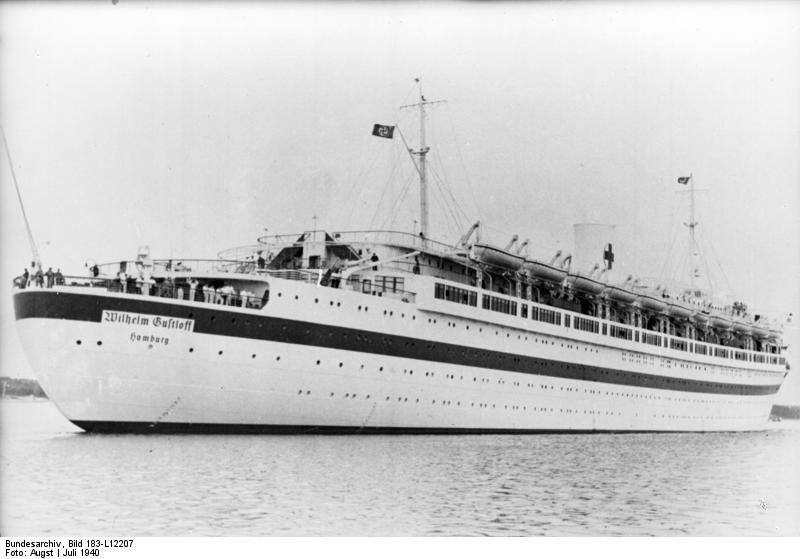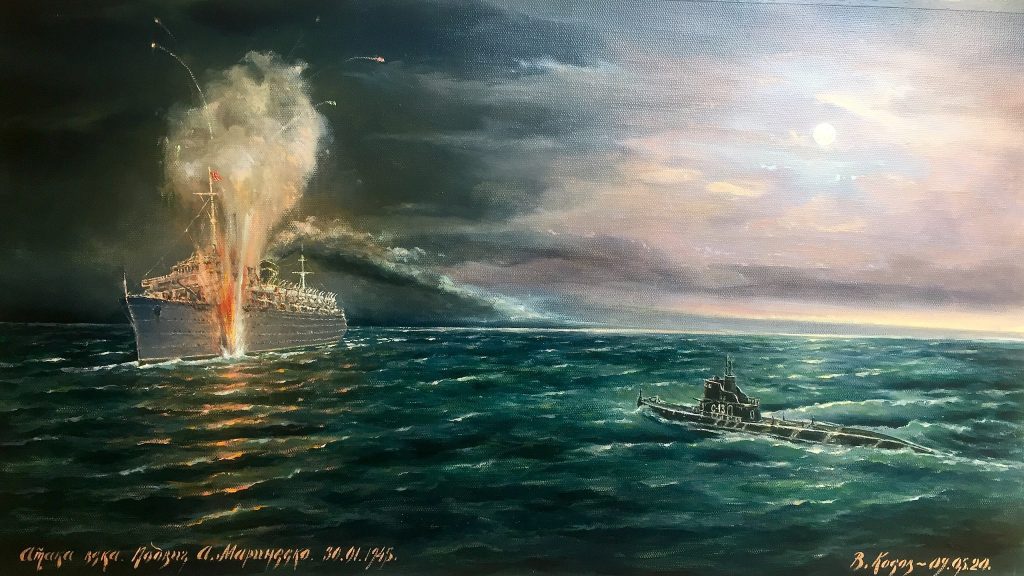The MV Wilhelm Gustloff, launched in 1937, was a German ocean liner initially used for leisure cruises.

Requisitioned for military use during World War II, it was tragically sunk by a Soviet submarine in January 1945, leading to the deadliest maritime disaster in history.
The sinking of the Wilhelm Gustloff, predominantly carrying German refugees and wounded soldiers, stands as a somber reminder of the immense human cost of war and the perils faced by civilians in conflict zones.
Background
The ship was launched on May 5, 1937, and named in honor of Wilhelm Gustloff, a leader of the Swiss branch of the Nazi Party who was assassinated in 1936.
This naming was symbolic, representing the Nazi regime’s practice of using public works and state-sponsored initiatives to propagate its ideology.
The MV Wilhelm Gustloff was initially used as part of the Kraft durch Freude program.
This program, translating to “Strength Through Joy,” was a large state-operated leisure organization in Nazi Germany.
It aimed to bridge the class divide by making leisure activities, such as vacations and cruises, accessible to the average worker.
The Gustloff played a key role in this, being used for pleasure cruises in the Baltic and North Seas, and even as far as the Mediterranean.
These cruises were heavily promoted as a demonstration of the benefits of the Nazi regime to the German people.
With the outbreak of World War II in 1939, the ship’s role dramatically changed. The German Navy, the Kriegsmarine, requisitioned the Wilhelm Gustloff.
Initially, it served as a hospital ship, providing aid and medical care during the early years of the war.
This role was in line with international agreements about the use of hospital ships. However, as the war progressed, the Gustloff’s functions expanded.
 The Wilhelm Gustloff as a hospial ship in 1940. Image by Bundesarchiv CC BY-SA 3.0 de
The Wilhelm Gustloff as a hospial ship in 1940. Image by Bundesarchiv CC BY-SA 3.0 de
Eventually, the Gustloff was repurposed as a floating barracks for the rapidly expanding U-Boat arm of the Kriegsmarine.
Stationed in the port of Gotenhafen (now Gdynia, Poland), it housed U-boat trainees and personnel.
The Sinking Of The Wilhelm Gustloff
In early 1945, as the Soviet Red Army advanced into East Prussia, the German command initiated Operation Hannibal.
This operation was a massive naval evacuation, one of the largest in history, designed to rescue German troops and civilians trapped by the Soviet onslaught.
The Wilhelm Gustloff was mobilized for this operation, marking a drastic shift from its previous roles.
When the Wilhelm Gustloff set sail from Gotenhafen (now Gdynia, Poland) on January 30, 1945, it was overcrowded with refugees.
The ship, designed to accommodate around 1,900 passengers, was packed with over 10,000 people, including German soldiers, civilians, and wounded.
The precise number remains unknown, but it far exceeded the ship’s capacity.
Many were women and children, fleeing the advancing Soviet forces under dire circumstances.
The conditions on board were extremely challenging. The passengers, already traumatized by the war and the prospect of Soviet occupation, faced overcrowding, limited supplies, and harsh winter weather.
The Baltic Sea in winter was notoriously treacherous, with freezing temperatures and icy waters posing a serious risk.
The ship’s captain, Friedrich Petersen, faced a critical decision: whether to sail close to the coast, where the ship would be less exposed to submarine attacks but more vulnerable to mines, or take a route further out to sea, where the risk of submarine attacks was greater.
Petersen chose the latter, also deciding to sail with the ship’s red and green navigation lights on, making the Wilhelm Gustloff an easy target.
The worst fears were realized when, on the evening of January 30, the Soviet submarine S-13, commanded by Captain Alexander Marinesko, detected the Wilhelm Gustloff.
Marinesko ordered a torpedo attack, and three torpedoes struck the ship.
The torpedoes caused catastrophic damage, and the ship began to sink rapidly.
In the panic and confusion that ensued, the severe overcrowding and lack of adequate life-saving equipment proved disastrous.
Many passengers were trapped inside, while others jumped into the freezing sea.
Lifeboats were insufficient, and in the chaos, launching them proved difficult and sometimes impossible.
The Scale Of The Tragedy
The sinking of the Wilhelm Gustloff resulted in a death toll that far surpassed other well-known maritime disasters.
With estimates of around 9,600 fatalities, it exceeded the losses of the Titanic and the Lusitania combined. This staggering number makes it the deadliest maritime disaster in recorded history.
A significant factor contributing to the high death toll was the composition of the passengers.
The ship was filled with German civilians, including a large number of women and children, along with wounded soldiers and naval personnel.
The evacuation was part of a desperate attempt to escape the advancing Soviet army, leading to a chaotic and rushed boarding process that significantly exceeded the ship’s intended capacity.
 A painting depicting the attack, titled ‘Attack of the Century’. Image by Kosov vladimir 09071967 CC BY-SA 4.0
A painting depicting the attack, titled ‘Attack of the Century’. Image by Kosov vladimir 09071967 CC BY-SA 4.0
There were several factors that led to such a massive loss of life:
Overcrowding: The Wilhelm Gustloff was designed to hold about 1,900 passengers, but on its final voyage, it carried estimates of between 10,000 to 11,000 people.
This severe overcrowding made the evacuation and rescue operations incredibly difficult once the ship was struck.
Winter Conditions: The disaster occurred in the dead of winter, in the frigid waters of the Baltic Sea.
The extreme cold greatly reduced the survival time for those who ended up in the water, turning the sea itself into a deadly threat.
Lack of Life-Saving Equipment: The ship was not equipped with enough lifeboats or life jackets for all passengers, a problem exacerbated by the overcrowding.
Many lifeboats were also frozen and could not be launched properly in the chaos that followed the torpedo attack.
Aftermath
For many years after the war, the sinking of the Wilhelm Gustloff was not widely recognized or discussed, particularly in the divided Germany of the Cold War era.
It was a tragedy that involved German refugees at a time when the narrative of the war was focused on the crimes of the Nazi regime and the suffering of its victims.
This context delayed broader recognition and commemoration of the disaster.
In recent years, there has been a growing awareness and memorialization of the tragedy. Books, documentaries, and research have brought the story of the Wilhelm Gustloff to a wider audience, highlighting the human cost of war and the often overlooked tragedies that occur away from the battlefields.